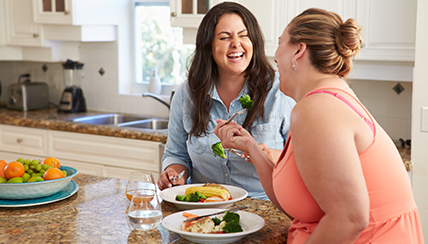Maintaining a Healthy Weight
Learn tips for losing and gaining weight, in an effort to maintain your ideal, healthy weight.
Help Losing Weight
 Being overweight puts you at risk for many diseases, including heart disease, diabetes, and high blood pressure. Some people with a chronic disease have trouble losing weight. For those with lung disease excessive body weight can increase shortness of breath.
Being overweight puts you at risk for many diseases, including heart disease, diabetes, and high blood pressure. Some people with a chronic disease have trouble losing weight. For those with lung disease excessive body weight can increase shortness of breath.
A good weight loss plan is one that includes all food groups. Avoid "fad" diets or diets that do not allow for a wide variety of foods.
Once you decide to lose weight, it is important to look at both the quality and the quantity of foods eaten each day. Most people can make improvements in both areas. Healthy weight loss can help decrease shortness of breath and improve your overall fitness, energy level, and sense of well-being.
Estimate Your Serving Sizes
One of the first steps to take in an effort to lose weight is to monitor your serving sizes. Use these tips as a way to cut down on portions.
1 cup is the size of a tennis ball, a baseball, or a fist.
½ cup is the size of a racquet ball or regular light bulb.
3 ounces of meat is the size of a deck of cards.
1 teaspoon of margarine is the size of the tip of a thumb.
1½ ounces of cheese is the size of a tube of lipstick.
It is important not to lose weight too quickly. Slightly decrease your intake of food so you're losing one-half to two pounds per week. Rapid weight loss is usually a loss of fluid or muscle, rather than extra body fat. Being physically active is also helpful when trying to lose weight.
More on serving size versus portion size.
Help Gaining Weight
If you have lost weight and are underweight you may need to make an extra effort to gain and maintain a healthy weight. Chronic lung disease can increase the risk of unintentional weight loss in part because of the extra effort needed to breathe.
Try some of these tips to help gain weight:
Plan small, frequent meals throughout the day if you can eat only small amounts of food at one time.
Drink juice and calorie-rich fluids instead of water. High calorie juices include apple, grape, cranberry, pineapple, prune, and all nectars.
Use more vegetable oil, butter or margarine. Avoid "light" products.
Do not fill up on low calorie beverages such as water, coffee, tea, diet colas, or bouillons before or during your meals. Instead, drink small amounts of low calorie beverages between meals or after eating.
Have snacks ready to eat. Nuts, dried fruits, cheese and crackers, granola, yogurt, ice cream, and popsicles are good high calorie snacks.
Avoid filling up on low calorie foods like salad at mealtime. Finish the heartier foods first so you consume an adequate number of calories.
Focus on high-calorie vegetables such as peas, corn, winter squash, sweet potatoes, white potatoes, and dried beans.
Ask your doctor or registered dietitian about nutritional supplements like Ensure, Boost, and Scandishakes.
This information has been approved by Emily McCloud, MS, RD (June 2012).
